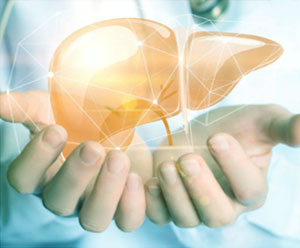Estrogen Replacement May Protect Against Liver Disease in Women
NAFLD – which stands for Nonalcoholic Fatty Liver Disease – is the most common cause of liver damage. It is a very serious disease of the liver that can lead to cirrhosis and eventual death. Nonalcoholic Fatty Liver Disease is also is one of the leading reasons that people must undergo liver transplants.
NAFLD is extremely common, affecting almost one in four (25%) of adults worldwide. In the United States, Nonalcoholic Fatty Liver Disease is the most common form of chronic liver disease, affecting about one-quarter of the American adult population.
As the name indicates, Nonalcoholic Fatty Liver Disease is not caused by drinking. Rather NAFLD is often associated with obesity, excessively high levels of lipids (fat) in the blood, and type 2 diabetes.
However, recent research has also proven that postmenopausal women have an increased risk of NAFLD as a result of the estrogen loss of menopause. The good news is that recent clinical studies also show that Hormone Replacement therapy (HRT) can be an effective preventative measure and treatment for Nonalcoholic Fatty Liver Disease.
What is Nonalcoholic Fatty Liver Disease (NAFLD)?
Nonalcoholic fatty liver disease (NAFLD) is a broad term that covers a wide range of liver disorders affecting people who drink little to no alcohol. As the name of the disease implies, NAFLD is characterized by too much fat being stored in liver cells.
NAFLD in some individuals can advance into nonalcoholic steatohepatitis (NASH), an aggressive form of fatty liver disease that is characterized by liver inflammation that can progress to into advanced liver scarring (cirrhosis) and liver failure.
Symptoms of Nonalcoholic Fatty Liver Disease (NAFLD)
In many cases people with Nonalcoholic Fatty Liver Disease have no obvious signs or symptoms, especially in the initial stages. When symptoms of NAFLD do develop, they may include:
- Fatigue
- Pain in the upper right abdomen
- Abdominal swelling
- Enlarged blood vessels beneath the skin’s surface
- An enlarged spleen
- Reddening of the palms of the hands
- Jaundice (yellowing of the skin and eyes)
Hormones & Nonalcoholic Fatty Liver Disease (NAFLD)
A recent review article in the Journal of Endocrinology by researchers from the Translational Genomics Research Institute (TGen) suggested that after menopause women are at higher risk for developing NAFLD.
This review of more than 60 clinical and experimental studies found that the risk of developing Nonalcoholic Fatty Liver Disease is higher in postmenopausal women than in premenopausal women. This is believed to support the belief that estrogen protects the liver from developing NAFLD. Stated conversely, when women experience the hormone decline of menopause, there is a loss of liver protection from estrogen which (combined with other factors) results in an increased risk of NAFLD risk in postmenopausal women.
That study went on to pinpoint the female endocrine hormone called estradiol (E2) which declines significantly following menopause. E2 is the major female sex hormone involved in the regulation of menstruation and the female reproductive cycles. Low levels of E2 are specifically equated with higher incidence of developing Nonalcoholic Fatty Liver Disease.
Treating Nonalcoholic Fatty Liver Disease (NAFLD)
The first step in treatment of NAFLD is typically weight loss through healthy eating and exercise. A weight loss of 10% of body weight is ideal, but improvement in the risk of NAFLD can be seen even with a 3% to 5% weight loss.
Theoretically, Vitamin E and other antioxidants could also help protect the liver from NAFLD by reducing or neutralizing the damage caused by inflammation. And in studies of people with NAFLD, those who drank two or more cups of coffee a day had less liver damage than those who drank little to no coffee.
However, hormone replacement therapy (HRT) is now being considered as a primary weapon in the arsenal of women’s liver protection. Based on this large amount of recent research, many doctors believe that postmenopausal women may potentially benefit from estrogen replacement to reduce the risk factors of developing Nonalcoholic Fatty Liver Disease.
Hormone Replacement Therapy
If your primary care physician or nephrologist (kidney doctor) has diagnosed you with Nonalcoholic Fatty Liver Disease, or has said that you are at risk for NAFLD, restoring your estrogen levels may be beneficial. Blood testing by a Certified SottoPelle Hormone Provider can identify your specific hormone deficiencies, and see if your estrogen / estradiol / E2 levels are below normal levels.
Once your hormone levels are assessed your Certified SottoPelle Hormone Provider can prescribe customized, time-released hormone replacement pellet therapy to restore your hormone levels to the proper balance. Since Nonalcoholic Fatty Liver Disease problems and risk factors are often reversible if identified early enough, the SottoPelle BHRT pellet method may be able to help you reduce your risk of NAFLD, advanced liver scarring (cirrhosis), liver failure and death.
IMPORTANT DISCLAIMER: This article is provided as general information only and is not intended to be used as medical advice. While the benefits of hormone replacement are well documented through clinical research, we are not representing that hormone therapy is a “cure” for any disease. Only your treating physician can determine if hormone replacement may be a beneficial part of your healthcare regimen, based on your age, overall health, risk factors, and lifestyle.


